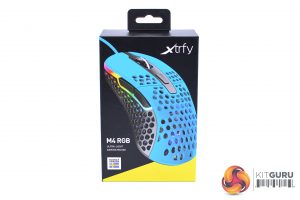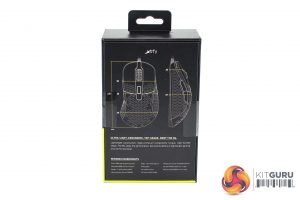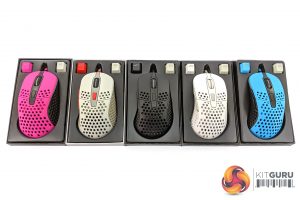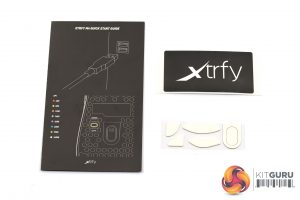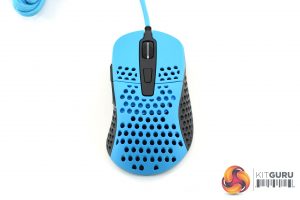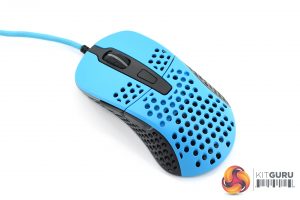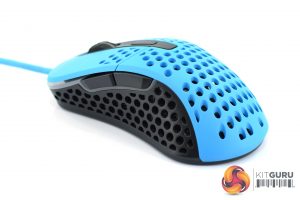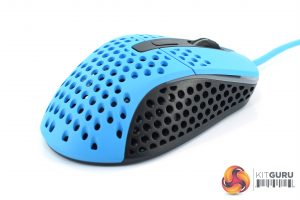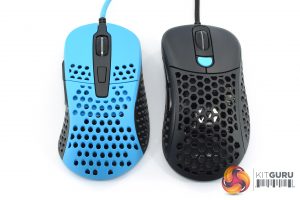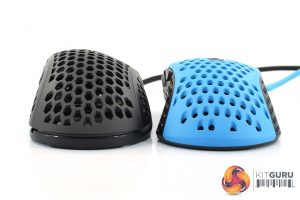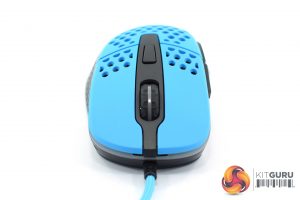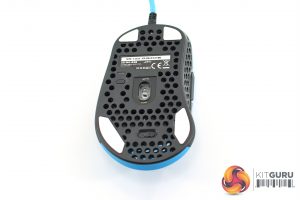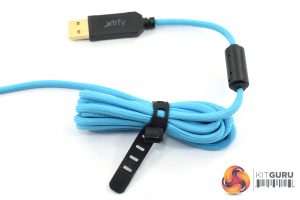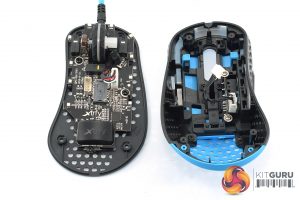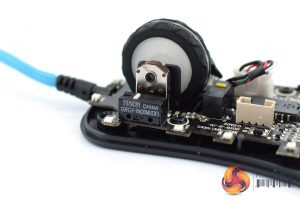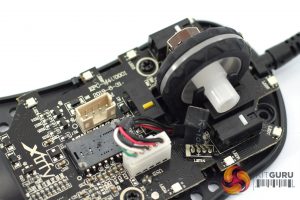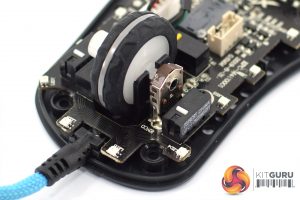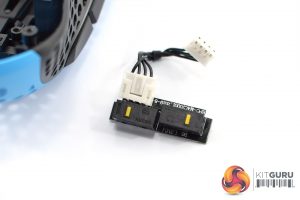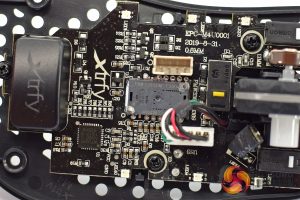The Xtrfy M4 RGB ships in a mostly black box, with a product photo dominating the front. On the back we can see a diagram of the mouse's dimensions, as well as some key specifications.
For the purposes of this review I am photographing the blue model, however above you can see all five of the colour options. From left to right we have: pink, retro, black, white, and blue. It's worth pointing out that the retro model does actually cost more than the others – currently OCUK sells the retro option for £57.95, whereas the others are all £49.99.
I also like that Xtrfy has included two keycaps as part of the M4 bundle – one of which is a grey/beige colour emblazoned with the letters ‘GG', while the other cap matches the colour of your chosen mouse and carries the Xtrfy logo. It's a small thing but a nice touch from Xtrfy. Additionally, a quick start guide, Xtrfy sticker and replacement set of mouse feet also come included in the box.
Looking closer at the mouse itself, it's clearly an ergonomic design and it shares some design similarities with the Zowie EC series. That said, I wouldn't call this an ‘EC clone' as there are a few areas of difference which we will get to below. As a general overview, though, we can see a significant outward curve towards the back on the left hand side of the mouse, while the right side also flares outwards slightly.
In terms of dimensions, the M4 measures 120 x 68 x 39mm (L x W x H). That width measurement is taken from the very back of the mouse, so the actual width of the M4 is 60mm where you would grip it. At 120mm long, too, you can tell this isn't a huge mouse – it's actually the same exact length as the Zowie EC2-B, so I'd class it as ‘medium size'.
We can also see Xtrfy has covered both sides of the mouse in holes, when some ultra-lightweight mice leave the sides as solid panels. The holes themselves are also circular instead of the honeycomb style we have seen on multiple other ultra-lightweight mice.
As this is a mouse exclusively for right-handers, there are two side buttons on the left of the M4, but none on the right side.
Above we can see a side-by-side comparison of the M4 RGB with the Sharkoon Light2 200 – itself a Zowie EC clone. There are of course broad similarities in terms of the overall shape, but again the curve on the M4's left-hand side is much more pronounced than the Light2. Additionally we can also see the hump towards the back of the M4 is much flatter; it still slopes upwards towards the left-hand side but not nearly as much as the hump on the Light2.
At the front, we can see the two primary buttons which are separate from the main shell of the M4. These don't have any comfort grooves built in. In between the buttons sits the rubber scroll wheel, and behind that is another very low-profile button – ordinarily this would change DPI, but with the M4 this is dedicated to adjusting the RGB lighting.
As for the underside of the mouse, this is again filled with more holes. We can also see four small PTFE feet, as well as a small slider which can adjust polling rate from 125Hz, to 500Hz, to 1000Hz. Additionally, to the left of the sensor lens we find another small button – this is for changing DPI, with a total of 8 stages to choose from. These are: 400, 800, 1200, 1600, 3200, 4000, 7200 and 16000.
The cable is known as the Xtrfy ‘EZCord', it measures 1.8m and it's another cable designed to be paracord-esque in terms of its flexibility and lightness. The colour of the EZCord also varies to match whichever colour option you went for, which is a nice touch.
Taking the mouse apart to look at the internals, we can get a look at the switches used for the primary buttons – as expected, these are Omron D2FC-F-7N(20M).
Both the scroll wheel click and the RGB button use Huano yellow switches, while the scroll wheel encoder is a brown F-Switch model.
The side buttons are housed in the top shell of the M4 so connect to the PCB via a short cable, and once more these are Huano yellow switches. The last thing to mention is the PMW 3389 sensor in the middle of the PCB.
Be sure to check out our sponsors store EKWB here
 KitGuru KitGuru.net – Tech News | Hardware News | Hardware Reviews | IOS | Mobile | Gaming | Graphics Cards
KitGuru KitGuru.net – Tech News | Hardware News | Hardware Reviews | IOS | Mobile | Gaming | Graphics Cards


